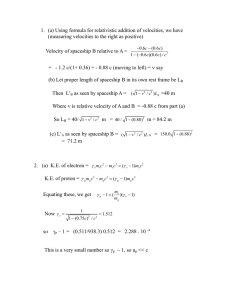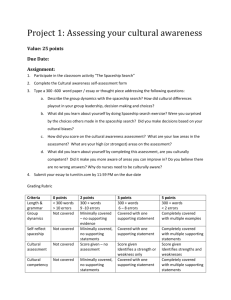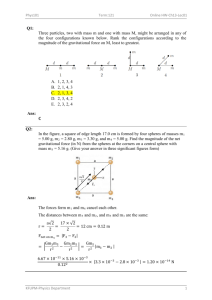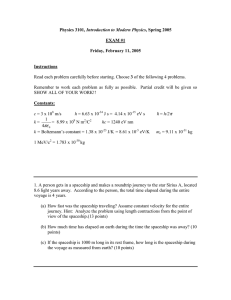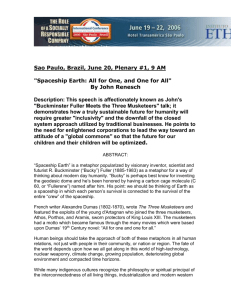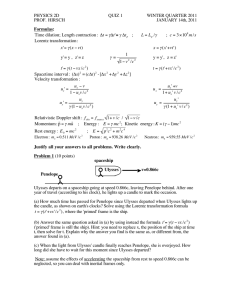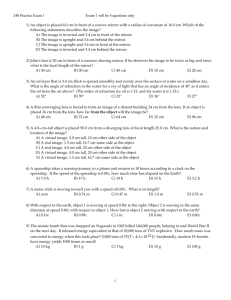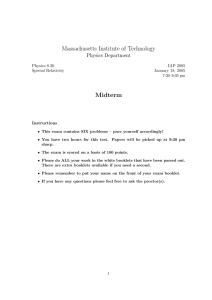PHYSICS 2D QUIZ 1 WINTER QUARTER 2009 PROF. HIRSCH
advertisement
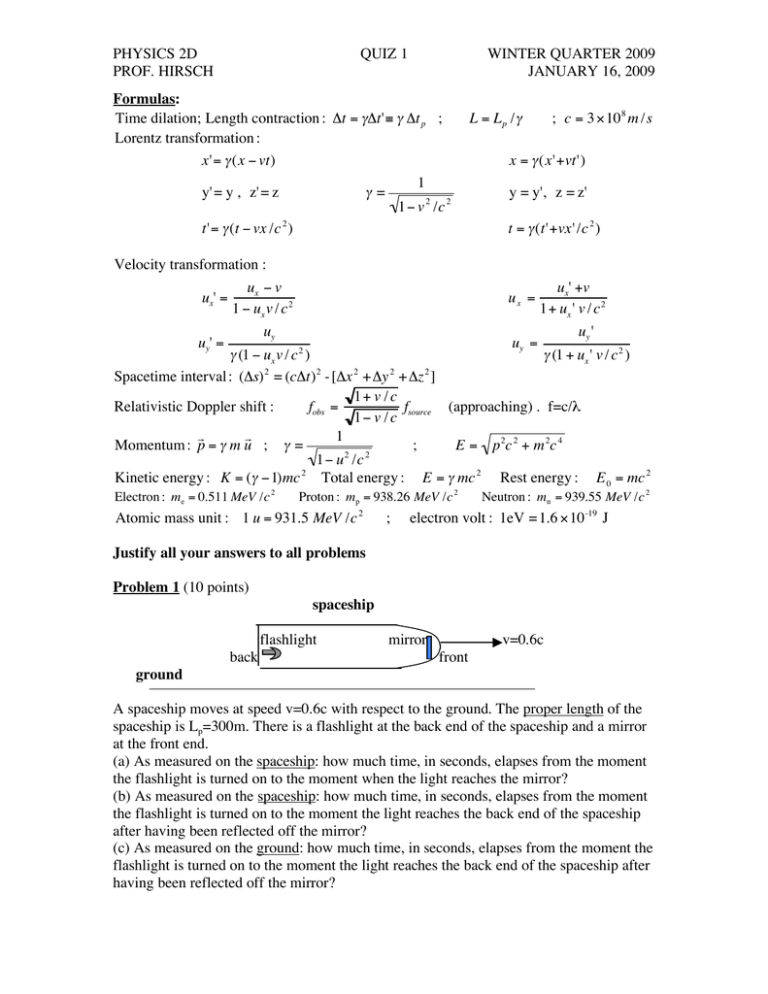
PHYSICS 2D PROF. HIRSCH ! ! ! QUIZ 1 Formulas: Time dilation; Length contraction : "t = #"t'$ # "t p ; Lorentz transformation : x'= " (x # vt) 1 y' = y , z' = z "= 1# v 2 /c 2 t'= " (t # vx /c 2 ) ! ! L = Lp /# ; c = 3 %10 8 m /s x = " (x'+vt') y = y', z = z' t = " (t'+vx' /c 2 ) Velocity transformation : ux ! v ux' +v ux' = ux = 2 1 ! ux v / c 1+ ux ' v / c 2 uy uy ' uy' = u = y " (1 ! ux v / c 2 ) " (1 + ux ' v / c 2 ) Spacetime interval : ("s) 2 = (c"t) 2 - ["x 2 + "y 2 + "z 2 ] 1+ v / c Relativistic Doppler shift : fobs = f (approaching) . f=c/λ 1! v / c source r r 1 Momentum : p = " m u ; " = ; E = p 2c 2 + m 2c 4 2 2 1# u /c 2 Kinetic energy : K = (" #1)mc Total energy : E = " mc 2 Rest energy : E 0 = mc 2 Electron : me = 0.511 MeV /c 2 ! ! WINTER QUARTER 2009 JANUARY 16, 2009 Proton : mp = 938.26 MeV /c 2 Atomic mass unit : 1 u = 931.5 MeV /c 2 ; Neutron : mn = 939.55 MeV /c 2 electron volt : 1eV = 1.6 "10 -19 J Justify all your answers to all problems Problem 1 (10 points) spaceship flashlight back mirror v=0.6c front ground A spaceship moves at speed v=0.6c with respect to the ground. The proper length of the spaceship is Lp=300m. There is a flashlight at the back end of the spaceship and a mirror at the front end. (a) As measured on the spaceship: how much time, in seconds, elapses from the moment the flashlight is turned on to the moment when the light reaches the mirror? (b) As measured on the spaceship: how much time, in seconds, elapses from the moment the flashlight is turned on to the moment the light reaches the back end of the spaceship after having been reflected off the mirror? (c) As measured on the ground: how much time, in seconds, elapses from the moment the flashlight is turned on to the moment the light reaches the back end of the spaceship after having been reflected off the mirror? PHYSICS 2D PROF. HIRSCH QUIZ 1 WINTER QUARTER 2009 JANUARY 16, 2009 (d) As measured on the ground: how much time, in seconds, elapses from the moment the flashlight is turned on to the moment when the light reaches the mirror? Explain your reasoning. Hint: (d) is more difficult than (a), (b), and (c); it can be done with or without using the Lorentz transformation formulas. Problem 2 (10 points) 0.3c 0.7c λg=550nm Green Red λr=650nm ground A green and a red spaceship are moving towards each other at speeds 0.3c and 0.7c respectively relative to the ground. (a) What is the wavelength of the light emitted by the red spaceship as seen by an observer on the green spaceship? (b) What is the wavelength of the light emitted by the green spaceship as seen by an observer on the red spaceship? Note: the red spaceship emits red light (of wavelength λr=650nm) as seen by an observer that is at rest with respect to it, and similarly for the green one. Problem 3 ( 10 points) Initial M Final at rest 0.6c m1 m2 0.8c An unstable particle of mass M at rest decays into two fragments of masses m1 and m2 that fly off at speeds 0.6c and 0.8c respectively in opposite directions. (a) Find m1 and m2 expressed in terms of M. (b) Find what fraction of the mass M was converted into energy. (c) Find the kinetic energy of the two fragments and show that they add up to the result in point (b) times c2, as expected from energy conservation. Justify all your answers to all problems
